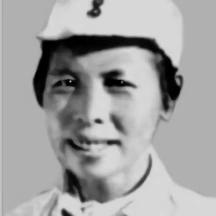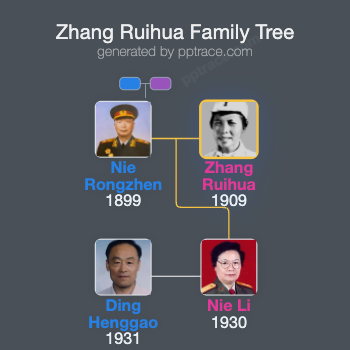
Zhang Ruihua
| Name | Zhang Ruihua |
| Title | The wife of Marshal Nie Rongzhen |
| Gender | - |
| Birthday | 1909-02-11 |
| nationality | — |
| Source | https://www.wikidata.org/wiki/Q106714007 |
| pptrace | View Family Tree |
| LastUpdate | 2025-10-01T11:02:57.532Z |
Introduction
Zhang Ruihua (February 11, 1909 – February 23, 1995), courtesy name Ruihua, was a native of Xinyang County, Henan Province. She was born into an ordinary family and began paying attention to the dark phenomena in Chinese society from a young age. After reaching adulthood, she was admitted to Xinyang Girls' Normal School, where she was influenced by underground members of the Chinese Communist Party and participated in organizing the "Yao Mang Society," reading progressive literature, and receiving Marxist enlightenment education.
In 1925, she participated in the May Thirtieth Movement, leading members of the "Yao Mang Society" to engage in anti-imperialist activities, organize demonstrations and parades, and raise funds to support the Shanghai workers' movement. In 1926, as the Northern Expedition Army reached Wuhan, Zhang Ruihua passed the entrance exams to the Wuhan branch of the Whampoa Military Academy with the help of underground Party members. That same year, she officially joined the Chinese Communist Party. She served as class monitor of the female squad at the school, actively studying military and revolutionary theory.
After the "September 18 Incident," the Wuhan Military Academy was incorporated into the Central Independent Division, and Zhang Ruihua supported frontline work under Ye Ting's command. In 1927, she participated in the Nanchang Uprising and later moved south to Guangzhou, participating in the Guangzhou Uprising as part of the general headquarters of the uprising. Following the failure of the Guangzhou Uprising, she fled to Hong Kong and subsequently carried out underground communication work for the Guangdong Provincial Committee, frequently traveling between Guangzhou, Kowloon, and Hong Kong to transmit secret documents.
In April 1928, she married Nie Rongzhen. In 1930, she followed her husband to Tianjin and Shanghai, where she worked in secret with the Central Special Branch and central agencies. In spring 1932, she worked at the liaison office of the Comintern's Far East Bureau in Shanghai.
In 1934, due to betrayal by a traitor, she was captured and imprisoned but managed to keep the party’s secrets and was released without charges. After her release, she worked at the central underground printing factory. From 1935 to 1936, she moved through Shaanxi Ba'an, serving successively in the Organization Department of the Shaanxi-G甘-Ning Provincial Committee and the party general branch of provincial organs.
During the Anti-Japanese War, she worked in Yan'an and Jin-Cha-Ji areas, including organizing Party schools and women's work committees. In 1943, she was elected as a delegate to the Seventh National Congress of the Party. After the war, she participated in nationwide propaganda and women's work. From the 1950s onwards, she held important positions in the North China Bureau and the Central Organization Department. In 1956, she became a delegate to the Eighth Party Congress, and in 1964, she was elected as a deputy to the National People's Congress.
During the Cultural Revolution, she suffered persecution from Lin Biao and the "Gang of Four," enduring great physical and mental hardship, but she remained steadfast in her beliefs and resolutely fought against forces attempting to destroy the Party and the state.
After 1978, she served as a member of the Standing Committee of the National Committee of the Chinese People's Political Consultative Conference and was elected as a member of the Central Discipline Inspection Commission. In 1989, she became a director of the Huangpu Alumni Association and actively participated in party-building activities. She passed away from illness in Beijing on February 23, 1995, at the age of 86.
Her family members include her husband Nie Rongzhen, her daughter Nie Li, and son-in-law Ding Henggao.
Family Tree
Tap to expand more relatives
